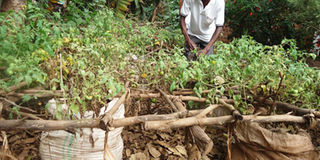Prime
With a little space, he set up his farm in sacks

Joseph Gitta in the sack garden he set up outside his house in Kayunga Town. Photo by Fred Muzaale.
What you need to know:
With the need to feed his family as well as earn more money to supplement his driver’s salary, he started sack gardening. He told Fred Muzaale why this was the best option for him.
My name is Joseph Gitta. I am a resident of Namagabi village in Kayunga Town, Kayunga District. I am employed as a driver by Buvuma District local government. Besides my day job, I am also a commercial farmer who engages in sack farming in my 60 by 70 feet plot of land, which I bought in 1998.
After buying the plot, I realised that I needed to engage in farming to supplement my salary as a source of extra income as well as be able to grow food for my family.
Getting idea
What prompted me to look for an option is that the soil on my piece of land was not only rocky but also was of low fertility to support proper crop cultivation.
As I contemplated on what to do so that I can guarantee food security in my home, I decided to take on sack farming, which I had seen some of the area residents practice after being trained by Caritas, a Catholic development organisation that promotes development.
After adopting the idea, I started to look for where I could get free fertile soil, sacks and polythene bags. So, I went to a friend who stays in a nearby village, called Kiteredde, who offered me fertile soil from his piece of land. In order not to incur high costs, I used my bicycle to transport all the soil to my plot.
For a start, I set up nursery beds for tomato and egg plant. I later went to Kayunga Town, where I bought 67 sacks, each at Shs700 and also picked about 30 polythene bags from garbage pits and other places in the town.
Starting
I got cow dung, ash, small stones, and small pieces of sticks which I mixed with the soil. I later put the soil in sacks. I drilled small holes on the sides of the sacks to allow water to move through and to improve air aeration.
When the tomatoes were ready for transplanting, I transferred them to the sacks, which I already placed in my plot. I planted yams and other fruits in some of the other sacks.
Every morning, while I was away at work in Buvuma District, my wife watered the sack gardens and also sprayed the plants with pesticides. After three and a half months, I started harvesting the tomatoes.
Earnings
At the end of the season, I had got 15 boxes of tomatoes from 80 sacks. From the tomatoes, I earned Shs900,000. Each box was sold at Shs60,000. At that time, the demand for tomatoes was high on the market. I also harvested yams from 10 sack gardens and from these, I got Shs250,000.
All the produce was sold to local traders and residents of the village, who came to my garden looking for them. After realising that this type of farming was profitable, I decided to increase the number of sack gardens to 110.
Some of the sacks I had used, especially those where I grew yams, had got torn as yams grew so I replaced them.
Currently, I have vegetables to supply to the market every season and I got a contract to supply tomatoes to Kayunga SSS. On average, I earn Shs400,000 a month from selling vegetables.
This type of farming allows me to grow crops throughout the year even during the dry spells.
Train others
Sometimes when I notice that there is a heavy storm coming, I can remove some of the gardens and put them inside my house and then put them back after.
I now train farmers on how to start and manage sack gardens because many urban dwellers can grow their own food, especially vegetables or fruits on the verandah or in the compound. In this way, they save money they would have used to buy these foods from the market.
With the proceeds from my sack gardens, I plan to buy a piece of land to plant maize, bananas and coffee. This will enable me carry commercial farming at a much larger scale than I have been doing.
=======================================
Expert take: How to start a sack farm, advantages and disadvantages
Sack farming is a type of agriculture where a farmer grows crops in soil-filled sacks or polythene bags. This type of farming is practiced by urban dwellers, who have limited space for growing crops or rearing animals or any other type of agriculture.
This method is also good where the gardener may have to continually relocate because he or she does not own the place but rents it or those, whose nature of work involves movement to differrent areas, for instance, policemen or soldiers.
Purpose
Urban dwellers who live in rented houses are best placed to undertake sack farming. They can grow vegetables in sacks on the verandahs, either for their own consumption or for sale to earn extra income. They can also do it for both purposes.
Sack farming is a very good option for landless households to ensure their nutrition security.
He adds that sack farming can also be the solution for people who have land that has low soil fertility or is too rocky to support the cultivation of crops.
With this method, the container, soil preparation, and other requirements are all taken care of. The sack gardens are filled with soil mixed with farm-yard or compost manure, cow dung or chicken droppings to nourish the soil.
Rwebikire, however, notes that not all crops can be grown in sacks. He says crops like tomatoes, cabbages, onions, pepper, dodo and mushrooms can be grown in containers.
After planting, the sack gardens can be placed anywhere as long as the plants will receive enough sunlight for their growth.
Watering of the “gardens” should be carried out appropriately. In case there is a hailstorm or any other kind of adverse weather, the “gardens” can be shifted to a shelter and only returned to their spot afterwards.
Advantages and disadvantages
The main advantage of sack farming is the portability as well as high productivity at low cost.
The method can be used where population density is high and in cases of scarcity of arable land.
However, its main disadvantage is that the sacks are needed for one to practice it. Sacks or polythene bags, if poorly disposed, are harmful to the environment.
James Rwebikire, Naads coordinator, Kayunga District




